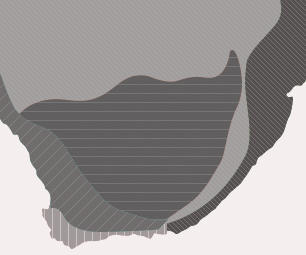Diascia vigilis
Diascia vigilis Hilliard & B.L. Burtt
Family: Scrophulariaceae
Common names: twinspurs (Eng.); horingkies (Afr.)
Introduction
Diascia vigilis is a superior species with an attractive habit and a long flowering season and makes a fantastic addition to a summer bedding display.

Description
Description
Diascia vigilis is a fast-growing, semi-deciduous, erect to semi-prostrate stoloniferous herbaceous perennial. Tufted, branched stems are produced from the crown of the stolons. The mature plants reach up to 300 mm high and spreads sideways, rooting as it goes, forming a mat of light green leaves. Leaves are broad, rounded at the base and tapering toward the end or slightly elongated and either hairless or slightly hairy.

Single flowers are arranged along an elongated, unbranched axis (raceme) forming an inflorescence and produced on the terminal branches. The masses of pale pink to salmon flowers are produced abundantly in late spring through summer and in favourable conditions into autumn. Individual flowers present themselves with a long broad lower lip and four smaller bonnet-type petals with translucent interior markings referred to as windows. The dark yellow and maroon window is visible on the upper petals, is fairly deep set and concave.

The common name twinspurs refers to the two lateral corolla tube spurs which curve out, down and slightly forwards with a patch of dark sessile glands within. These glands are oil-bearing cells called elaiophores and the oil attracts pollinators. The capsules are 7-11 mm long, containing urn-shaped seeds which are curved, winged and ridged.
Conservation Status
Status
Least Concern (Raimondo et al. in prep.)
Distribution and habitat
Distribution description
Diascia vigilis is found at altitudes of 1800-2440 m in the Drakensberg. Specimens have been recorded from the Tugela River Valley, Mont-aux-Sources, Cathedral Peak and Leribe, in western Lesotho, to the Platberg of the lower Drakensberg in the Orange Free State near Harrismith.
There is little difference between specimens growing at high and lower altitudes. The spurs of those from lower altitudes are slightly shorter and there are no gland dots on the lower lip-like petal. There are exceptions, however, as some low altitude specimens have spurs of normal length, but with an underdeveloped patch of gland dots.
D. vigilis may be found along the borders of mountain streams in the shelter of large rocks and on damp banks at forest margins. At higher altitudes it grows in the shelter of moist cliffs, among big rocks. It can form large tangled clumps and will occasionally scramble up through bushes. The extent of stem and leaf hairiness is extremely inconsistent within populations and variable forms grow intermingled.
Care is needed to distinguish between Diascia vigilis and D. fetcaniensis from the southern Drakensberg as both show similar variant hairiness. Diascia vigilis is often misidentified as D. barberae, which can be distinguished by the two lateral patches of gland dots on the palate and the more deeply concave corolla tube which forces the calyx segments to reflex.
Diascia vigilis occurs in a summer rainfall area and thrives with adequate watering; however, it is fairly drought tolerant too. It is best suited to areas that are not too humid and hot and requires good drainage. Its hardiness to temperature and frost is also variable and seems to be area specific.
Derivation of name and historical aspects
History
There are 70 species of Diascia endemic to South Africa found mostly in the eastern regions including Lesotho, Transkei, Orange Free State, Natal and Eastern Cape Province. The latter in which mostly annuals are found.
Diascia is derived from the Greek words, di, two, and askos, sac, referring to the pair of translucent yellow sacs/windows in the corolla and not to the two spurs which are absent in the type specimen D. bergiana. In most annuals, Diascia species follow this example, but in the perennials, the window is single or only slightly doubled. This double spur, though, is a striking characteristic of many Diascia species. The spurs contain glandular hairs which secrete fatty oil. In some species, small dark patches of these tiny glands are also found on the face of the flower. The oil is harvested by members of a genus of bee which evolved to reach into the spurs of the flower.
Many of the collections of D. vigilis come from the valley of the Tugela River and its name is derived from an area landmark, The Sentinel. The Sentinel (the Latin word is vigil ) is a huge basalt rock on the northern end of The Amphitheatre in the Royal Natal National Park.
Diascia elegans is in fact D. vigilis. This epithet was an unpublished name, provisionally used while the genus was being studied, and to avoid confusion, should not be used.
The earliest record of Diascia vigilis is in 1895 when Thode cited the species at Witzieshoek, Caledon Pass in the Orange Free State. Hilliard & Burtt recorded the species in the Orange Free State and Natal, and accessioned specimens of D. vigilis were housed in the Royal Botanic Garden, Edinburgh in 1981 and 1982.
Diascia vigilis is similar to D. anastrepta with upward-pointing spurs. Other species common to gardeners either through hybridization or selection include D. rigescens, D. integerrima, D. fetcaniensis and D. mollis
Ecology
Ecology
Diascia species are pollinated by a specialized genus of bee, Rediviva, whose forelegs have evolved to as much as three times their normal length in order to reach into the spurs of the flower, to harvest the fatty oil produced by the glands. This modification seems to be restricted to the females, as few males of the species have been found to have excessively long forelegs. Upon landing on a flower, she will insert her elongated front legs into each hollow spur and probe the ends for the oil-producing elaiophores. The bee's legs are made up of a complex system of setae adapted to cutting open oil-bearing cells and absorbing the contents, almost like a sponge. While the female bee is collecting oil with her forelegs extended into the spurs, the flower's group of anthers are pressed against the body of the bee. Thus pollen is carried from one flower to another and pollination occurs.
Additionally, those species of Diascia which tend to grow together in an area have evolved different arrangements of their stamens so that their pollen is deposited on separate parts of the bee's body, thereby avoiding cross pollination.
Uses
Use
In 1978, Hector Harrison of Appleby in South Humberside, acquired three species of Diascia and in 1984 found out about their specialized pollination needs. Thereafter, he started breeding them by hand cross pollination and in the mid-1980s, his first hybrids were flowering. What started as a hobby turned into a breeding programme and some of the earliest Diascia cultivars were introduced by Harrison. He was a keen gardener and enjoyed passing on good plants to others to appreciate, including nurseries. Harrison's generosity in spreading his plants so widely, made it impossible for him to register them for Plant Breeders' Rights.
Diascia species and their cultivars are still very popular as a summer ornamental herbaceous plant in hanging baskets, pots, rockeries and flowerbeds.
D. vigilis is a fantastic addition to border plantings and pots and complements or softens strong structural plants such as Eucomis autumnalis.
Growing Diascia vigilis
Grow
Diascia is a hardy, fairly drought-tolerant species. It thrives in sunny or lightly shaded positions. In the wild, it tends to grow along streams or in the moist shade of rocks or large grass tussocks. It can be surprisingly tough, for such a delicate looking plant. Some species root where their stems touch the soil while others spread from a mass of stolons which are easily removed and potted up.

Diascia are easily propagated vegetatively. Select non-flowering softwood cuttings, 50-60 mm long, taken when the plants are actively growing, in spring. Cuttings usually strike quickly, within two weeks, without heat or special treatment. For hollow-stemmed species it is better to try cuttings with a good node at the end or heel cuttings taken from basal shoots. Cuttings taken in autumn root and overwinter well, but thrive only once the weather warms up in spring. Plant rooted cuttings into small pots in a humus-rich, friable and well-drained potting mix.
Cut back mature plants in midsummer to improve the flower display. Diascia can regularly receive a good slow-release fertilizer to keep it vigorous and healthy.
Slugs and snails damage small plants. Red spider mite and mealy bug can be a troublesome pest which should be treated with an appropriate insecticide measure, either organic or chemical, as soon as noticed. Lack of sunshine will cause floppy, elongated growth. Usually Diascia are vigorous and pest free.
References
- Benham, S. 1987. Diascia - a survey of the species in cultivation. Plantsman 9,1: 1-17.
- Elliott, J. 1993. Small and perfectly formed: adaptable, low-growing perennials that won't invade your space. The Garden 118,6: 246-249. Royal Horticultural Society, London.
- Garbutt, S. 1994. Up-and-coming Diascia. The Garden 119,1: 18-21. Royal Horticultural Society, London.
- Hilliard, O.M. & Burtt, B.L. 1984. A revision of Diascia section Racemosae. Journal of South African Botany 50: 269-340.
- Leistner, O.A. (ed.). 2000. Seeds plants of southern Africa: families and genera. Strelitzia 10. National Botanical Institute, Pretoria.
- Powrie, F. 1998. Grow South African plants. National Botanical Institute, Kirstenbosch, Cape Town.
- Raimondo, D., Von Staden, L., Foden, W., Victor, J.E., Helme, N.A., Turner, R.C., Kamundi, D.A. & Manyama, P.A. (eds). in prep. Red List of South African plants. Strelitzia.
- Smith, C.A. 1966. Common names of South African plants. Memoirs of the Botanical Survey of South Africa No. 35.
- Vogel, S. 1984. Diascia flower and its bee - an oil-based symbiosis in southern Africa. Acta botanica neerlandica 33: 509-518.
- Whitehead, V.B. & Anthony, N.C. 1984. The bee, Rediviva longimanum Michener (Apoidea: Melittidae), collecting pollen and oil from Diascia longicornis (Thunb.) Druce (Scrophulariaceae). South African Journal of Science 80: 286.
Credits
Monique McQuillan
Kirstenbosch National Botanical Garden
October 2009
Plant Attributes:
Plant Type: Perennial
SA Distribution: Free State, KwaZulu-Natal
Soil type: Sandy, Loam
Flowering season: Spring, Early Summer, Late Summer, Autumn
PH: Acid
Flower colour: Pink
Aspect: Full Sun, Morning Sun (Semi Shade), Afternoon Sun (Semi Shade)
Gardening skill: Easy
Special Features:
Horticultural zones










Rate this article
Article well written and informative
Rate this plant
Is this an interesting plant?
Login to add your Comment
Back to topNot registered yet? Click here to register.